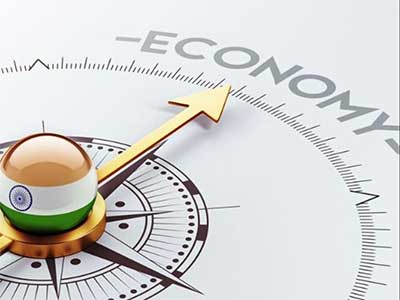Date : 20/12/2023
Relevance: GS paper 3 – Indian Economy
Keywords: GDP Growth, El Nino's impact, New India, Job Creation
Context-
India, with its burgeoning economy, has become a focal point of global attention. The recent upgrade of GDP growth to an impressive 7% for 2023-24 by the central bank has sparked enthusiasm, especially in the face of global economic challenges. Examining the factors driving India's outstanding performance reveals a multifaceted landscape of economic dynamics and transformative changes.
Rural Resilience Amidst Climate Challenges:
Initially, concerns loomed over weak rural demand due to El Nino's impact on rains and food production. Surprisingly, rural workers found alternative employment in the booming construction sector, fueled by government-driven capital expenditure. Robust housing demand provided a stable platform for rural employment and wages, intertwining with banking sector health and pointing towards sustained growth.
The Nexus of Banking, Housing, and Construction:
The interplay between bank credit, house prices, and construction cycles emerged as a crucial nexus. The banking sector's clean balance sheets supported further loan growth, contributing to the upswing. This synergy, though slightly softer than before, elucidates the recent growth upgrade, highlighting the resilience of India's economic ecosystem.
The Emergence of "New India":
Beyond the immediate horizon, India's growth prospects for the coming years have significantly improved. A pivotal player in this trajectory is the "new India," constituting approximately 15% of GDP. This segment is dominated by two high-tech sectors: the export of high-tech goods and services and India's robust digital public infrastructure.
High-Tech Exports and Services:
- India has gained global market share in high-tech exports like mobile handsets, pharmaceuticals, and IT services since 2017.
- Services exports have evolved beyond traditional roles, encompassing diverse professional services such as accounting, legal, and R&D.
- The emergence of Global Capability Centres has added a new dimension to India's service exports, propelling growth.
Digital Public Infrastructure and Tech Start-ups:
- Tech start-ups have seamlessly integrated into India's impressive digital public infrastructure, fostering rapid growth in sectors like fintech, e-commerce, ed-tech, and logistics.
- These start-ups have attracted substantial foreign capital, promoting a pro-entrepreneurship culture with wide-ranging benefits.
Sustainable Growth and Employment Challenges:
While the current growth trajectory is promising, the challenge lies in creating the necessary jobs for India's burgeoning population. The majority of the workforce is entrenched in the "old India," consisting of sluggish low-tech manufacturing and agriculture sectors.
Manufacturing Challenges:
- Small manufacturing firms often struggle to scale, hindering job creation and economic growth.
- Digitalization presents an opportunity for tech start-ups to energize manufacturing by providing smaller firms access to cheaper inputs, larger markets, and improved credit platforms.
Agricultural Transformations:
- Agriculture, employing 46% of the labor force, contributes only 16% to economic output.
- Digital innovations, including easier access to credit, can address challenges in the agricultural sector, but scaling up is essential.
How to address these Challenges
Start-ups in Energizing "Old India":
A paradigm shift can occur if tech start-ups, traditionally focused on services, venture into digitalizing manufacturing and agri-tech. By leveraging digital infrastructure, these start-ups can facilitate the growth of small manufacturing firms and bring about transformative changes in agriculture.
The Need for Economic Reforms:
While digital infrastructure applications offer temporary solutions, sustained and large-scale gains require comprehensive economic reforms. A market-friendly legal framework for agricultural e-commerce, improvements in ease of doing business across sectors, and addressing challenges in domestic capital expenditure, education, and employability are critical.
Projecting Future Growth and Job Creation:
With continued reforms, India's GDP could expand at a rate of 7.5% over the next decade, providing a solution to two-thirds of the country's jobs problem. However, this growth alone may not be sufficient, necessitating a holistic approach to address challenges in various sectors.
Global Dynamics and India's Position:
Considering the global economic landscape, two factors favor India's growth trajectory. Firstly, the world is witnessing a shift towards de-globalization in goods trade but remains open to globalization in services trade. India, with a substantial share of services in its GDP, stands to benefit from this trend. Secondly, a significant portion of India's capital stock planned for 2040 is yet to be built, presenting an opportunity to leapfrog into green technology and potentially boost exports and manufacturing.
Overcoming Obstacles to Green Growth
While the potential for green technology adoption exists, obstacles such as improving the finances of power distribution companies and establishing a coordinated institutional framework to address federalism, fiscal constraints, and bureaucracy must be tackled. A strategic and concerted effort is required to navigate these challenges and fully realize the benefits of green growth.
Conclusion
India's economic landscape is marked by a blend of traditional strengths and emerging opportunities. The interplay between "old India" and "new India," driven by technological advancements and digitalization, holds the key to sustained and inclusive growth. The path forward requires not only harnessing the potential of high-tech exports and digital infrastructure but also addressing challenges in manufacturing, agriculture, and economic reforms. With the right policies and strategic initiatives, India has the potential to not only maintain its current growth momentum but also become a global economic powerhouse, ushering in a new era of prosperity. The time is ripe for India to play its cards wisely and capitalize on the opportunities that lie ahead.
Probable Questions for UPSC mains Exam-
- Discuss the role of technology in transforming traditional sectors like manufacturing and agriculture. How can digitalization contribute to job creation and sustainable economic growth in developing countries? (10 marks, 150 words)
- Examine the impact of globalization trends on India's economy, focusing on the shift in goods and services trade. What are the challenges and opportunities for India in leveraging its services-oriented economy on the global stage? How can policy reforms enhance India's position in international trade dynamics? ( 15 marks, 250 words)
Source- The Hindu









